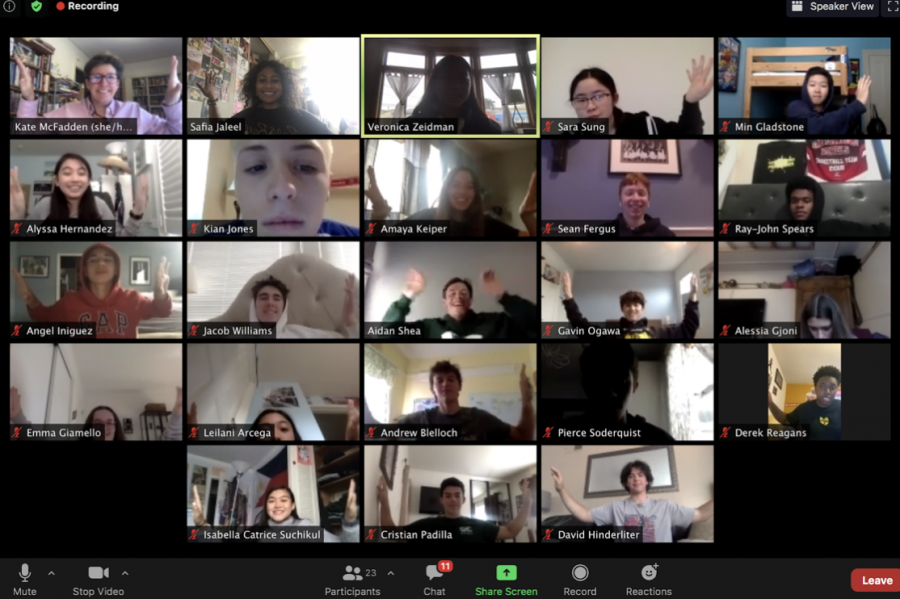Update: School Life in Times of Quarantine
Graphic Novels with Ms. McFadden (we tried to high five each other)
When SHC first closed due to the coronavirus in March, students were certain that we would be back in the presence of each other within two weeks. Here we are, six months later, graced with only the company of those on our screens. Summer 2020 was the longest one of my life; what would usually be a refreshing reset to welcome a new school year became a nightmarish blur of routine. When I got an email from Dr. Cannon announcing that we would be returning to a hybrid schedule — in which each student would attend school in person once a week, I thought it was too good to be true. My intuition was soon proved correct — his name once again popped up in my inbox, this time stating that we would be resuming school with 100% distance learning. Regardless, we are resilient, just like every other American who has lost their job, a family member, or been otherwise affected by the pandemic. In the words of Ms. Giovannetti — a math instructor — “the struggle is real, but we must keep trying to figure out how to make this situation work.” I’ve compiled insight into how the SHC community has been working to make the best of school life in the time of quarantine.
When asked if the distance learning workload is manageable, 61% of students (from an Instagram poll of 150 SHC students conducted on August 30th, 2020) agreed that, yes, it is. Compared to last year’s results, in which only 33% of students thought this to be the case, a massive positive shift is evident. While this could be chalked up to the time of year the poll was taken (the daunting fourth quarter vs. the “easy” first quarter), there is still reason to believe this will continue throughout the year. The implementation of Founder’s Fridays, where every Friday is a break from regularly scheduled classes and an opportunity to drop in for office hours, is a HUGE hit, with 84% of students feeling that these days are helpful. Jackie Santana ’21 states that Founder’s Fridays “give students a whole day to ask teachers questions instead of making them feel out of place during class time. I’ve used it, and it’s been super helpful and much easier to communicate one on one with a teacher.” Teachers seem to have the same sentiment; Mr. Ruiz, an ethics teacher, maintains that “from a wellness perspective, Founder’s Fridays provides a much needed mental break with opportunities for discussion about many topics.”
The idea of a “much needed mental break” is one that is shared across the board. 91% of the surveyed students affirmed that looking at their screens for three seventy-minute classes resulted in fatigue. Sofia Fighera ’21 states that “it’s too hard to stay engaged for three seventy-minute long classes a day,” while Camilo Cordova ’22 asserts that “it’s hard to focus for those who simply don’t do well just sitting in a seat.” This information is reflected in the mild distaste for this year’s synchronous schedule (Zoom calls are now held for every class) — 53% of poll participants miss last year’s asynchronous schedule. Stephen Ira ’21 believes that “zoom calls plus homework results in one’s whole day revolving around school work.” Others hold a different view. Isabella West ’22 says that “I don’t feel as much pressure to be perfect like I normally would in a classroom environment.” Mr. Ruiz believes that “the current schedule helps us, as a school, feel more connected to our students, or at least feel connected to the best of our ability. Checking in regularly with my students allows me to ensure they are ok and allows me to provide more structure to the students, which will ultimately help them succeed.”
It is easy to forget in the confinement of our screens, that our teachers deal with the same sore eyes and fuzzy brains as us after a day on Zoom. Plus, they have been putting in tremendous work to keep us on track. Ms. Kayser, who teaches government, outlined her experience with class planning over the summer — “I tried to focus on learning as much as I could about online learning. I learned all the buzz-words associated with distance learning. I occupied my time with reading and planning and stressing and plenty of sleepless nights.” Ms. McFadden — an English teacher — describes a similar experience: “I have to really think through and plan out every moment of class, have every last tech tool set up ahead of time, test out the tools ahead of time, and then hope it works. In-person, if something wasn’t working I would be able to pivot and still have a solid class but online if a tech tool fails, I’m not confident that I’ll know how to change things up to still make the class work. It all just feels so new and that alone can be exhausting.” While teachers and students have very different roles and goals, it is important to remember that we entered this as a community, and that sentiment still holds firm.
Even those new to our school, such as Ronan West ‘24, can sense its fervency. When asked about Freshman Fridays (where freshman meet with each other and an older “brother or “sister”), he declared that “obviously online school isn’t the ideal or most effective way to build a community, but I appreciate them making an effort to make us feel like the class of 2024 and not a bunch of kids thrown into classes with one another.”
We must keep our heads up, and realize that we are truly in this together. In Ms. Kayser’s words, “every time my mind starts to dwell on the ugly parts of distance learning, I am trying to teach myself to find the beauty amidst the chaos.”







Anonymous • Sep 4, 2020 at 4:46 pm
Good stuff! SHC truly is resilient and will get through this.